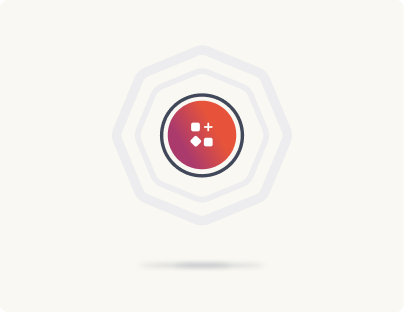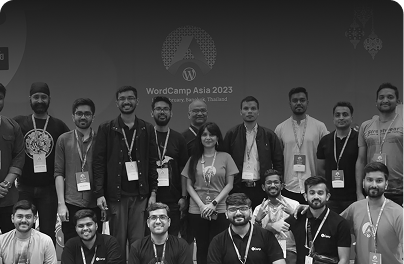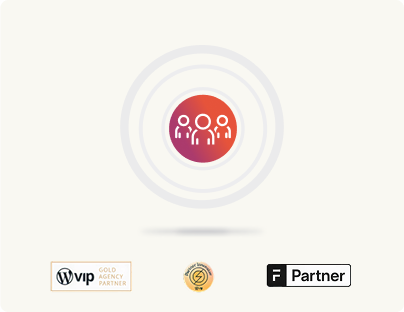Drupal vs WordPress: Multisite functionality
Large organizations and enterprises typically own multiple digital properties often representing different brands, solutions, or regional sites. This is why multisite management is another important criteria when choosing a CMS.
While both Drupal and WordPress offer multisite capabilities, when comparing Drupal vs WordPress for multisite management, it’s only WordPress that delivers the standardization, centralization, and scalability enterprises need to truly leverage on a multisite setup.
Before we see how WordPress does that, let’s see how Drupal approaches multisite setups.
Drupal’s multisite management
For multisite management, the Drupal vs WordPress analysis shows WordPress having a clear competitive advantage. In fact, Drupal doesn’t even position its multisite functionality as a deciding factor, because it’s not.
Drupal multisite is designed for specific use cases rather than broad enterprise adoption. So while Drupal does offer multisite capabilities (and extends its modularity to each site in the network) these are generally limited to certain types of site networks, making it more of a niche feature rather than a core benefit for large enterprises.
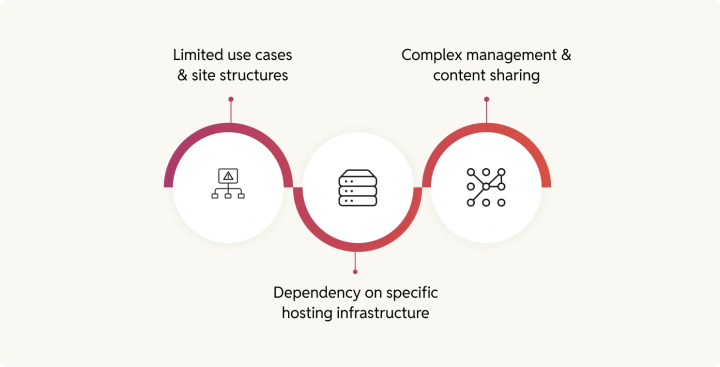
Drupal multisite is only for certain networks of sites
Read up on it, and you’ll see that it’s only suited for a select few use cases—for example, a site each for a department for a university website. Also, the sites, too, need to be structured in a certain way, limiting the flexibility of the platform for enterprises with complex, diverse site requirements. This too shows why Drupal’s multisite model may not be an ideal fit for every enterprise’s needs.
But there’s more.
Drupal multisite needs a specific hosting system to work the best
If you want to make the most of Drupal multisite, Drupal tells you to get a Drupal multisite hosting system (Aegir). As you can imagine, this additional infrastructure layer adds both cost and management overhead as the multisite setup becomes more tied to specific hosting infrastructure.
Drupal also highlights how its multisite management is quite complex:
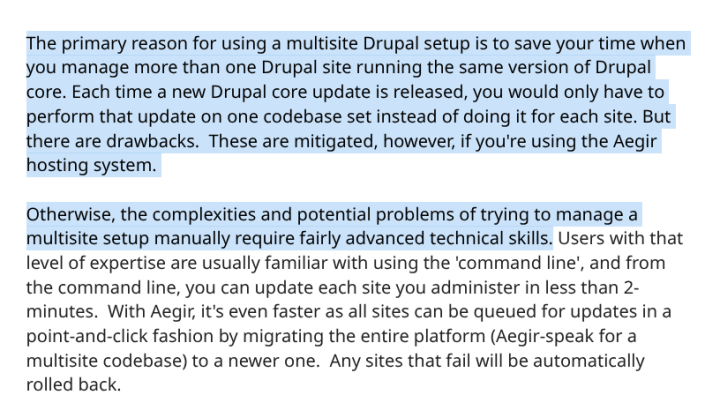
Drupal multisite management isn’t as seamless as you’d like
Managing multisite environments in Drupal is not as seamless as you might expect. The framework itself requires a considerable amount of configuration and ongoing management. For example, sharing content and media assets across subsites in a Drupal multisite setup would require a lot of specialized expertise.
WordPress’s multisite management
WordPress comes with a very mature multisite feature set right out of the box. When used strategically, WordPress Multisite isn’t just a solution for managing multiple websites—it’s a powerful system that enables centralized control, efficiency, and flexibility. Let’s go over how WordPress approaches multisite management and how Drupal compares.
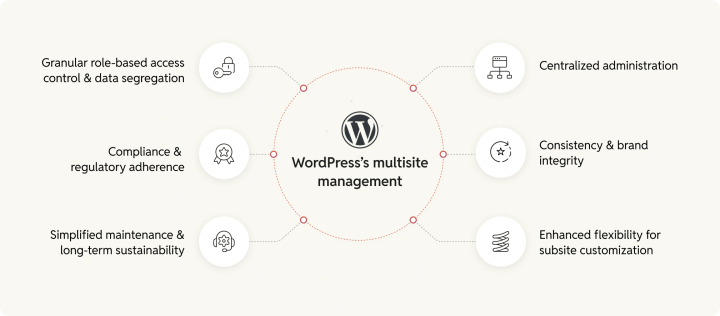
Centralized administration
WordPress Multisite allows you to handle all your sites from a single admin panel. This centralized management minimizes time spent on redundant tasks such as plugin updates, theme modifications, or security patches, as changes made at the network level propagate across all subsites automatically:
- Bulk plugin and theme management: Network-wide plugin installation, activation, and updates reduce maintenance time and ensure uniformity across all subsites. (It’s also possible to do these at the site level.) Themes, too, can be managed at both the network and site level.
- Automated backups and recovery: Backup processes for the entire multisite network can be scheduled and managed from a central interface, reducing complexity in disaster recovery scenarios.
- Unified user management: Centralized user roles and permissions allow admins to assign access across subsites without the need to manage accounts individually.
WordPress’s centralized multisite architecture reduces operational overhead significantly.
Consistency and brand integrity
WordPress Multisite ensures that all subsites adhere to common theme structures, branding guidelines, and functionality, promoting a unified and seamless experience across the board:
- Global theming: Admins can enforce uniformity by enforcing a global design system across all sites, ensuring consistent user experience and design integrity.
- Centralized codebase management: Developers benefit from an efficient, centralized codebase that applies updates to all subsites simultaneously, reducing risks of discrepancies in design and functionality.
- Shared database structure: Using a shared database allows multisite admins to maintain uniformity in site content, structure, and navigation across different subsites.
With these features, WordPress Multisite saves you from fragmented brand experiences.
Enhanced flexibility for subsite customization
Drupal vs WordPress multisite solutions also differ in the level of customizations they offer. WordPress Multisite gives you the perfect balance between control and customization.
Each subsite can be individually tailored to meet the specific needs of a department, region, or business unit/solution, without compromising the integrity of the overall network:
- Per-subsite configuration: Each subsite can have its own theme, plugins, and even custom configurations. This allows departments or teams to implement specialized features without affecting the main network or other subsites.
- Custom Post Types & taxonomies: Developers can define custom post types, fields, and taxonomies per subsite, enabling precise content structure and functionality tailored to each unit’s requirements.
- Multisite role & permission hierarchy: Role-based permissions on a granular level allows defining user access for specific subsites or functionality, without giving unnecessary access to the entire network.
WordPress Multisite ensures flexibility without sacrificing the overarching structure, allowing enterprises to address the unique needs of each business unit while maintaining consistency.
Granular role-based access control and data segregation
Another common theme in Drupal vs WordPress security discussions is Drupal’s granular role-based access control, which is undeniably robust. However, with the right customizations, WordPress can achieve similar levels of control.
WordPress Multisite’s role-based access control, network-wide settings, and individual subsite management ensure that your system remains secure while allowing for differentiated levels of access:
- Network-level security protocols: Apply security updates, firewalls, and SSL certificates across the entire network, ensuring uniform protection without redundant effort.
- Granular user permissions: Multisite allows administrators to assign roles and permissions per subsite, from site administrators to content editors, ensuring that sensitive data or functionality is restricted to authorized personnel. With customization, you can get even more granular control over your user roles and permissions.
- Segregated databases: Although subsites share a single database, they are isolated at the table level, providing a layer of separation that ensures subsites don’t have access to each other’s data.
With integrated security features, WordPress Multisite ensures a robust, scalable framework with centralized oversight to minimize risks across the entire network.
Compliance and regulatory adherence
Compliance and regulatory adherence is another consideration in the Drupal vs WordPress discussion around security. With WordPress Multisite, you can enforce compliance standards across the network with a centralized approach to data privacy, accessibility, and legal requirements:
- Centralized policy enforcement: Privacy policies, terms of service, and data handling procedures can be standardized across the network, ensuring regulatory compliance in every subsite.
- Regional data control: Multisite can manage region-specific settings for data storage, ensuring compliance with laws such as GDPR, CCPA, and other regional data protection regulations.
- Audit trails and logs: IT teams can set up network-wide logging to ensure every activity is tracked and compliant with industry standards, from user interactions to content changes.
WordPress Multisite’s compliance features reduce the risk of legal issues and ensure a smoother process for meeting complex regional regulations.
Enterprises using managed solutions like WordPress VIP also benefit from automated compliance checks, data protection features, and industry-standard certifications, ensuring alignment with regulatory requirements.
With Acquia for Drupal, achieving the same level of compliance often requires additional configurations, third-party integrations, and dedicated DevOps resources, leading to increased complexity and higher operational costs.
Simplified maintenance and long-term sustainability
Yet another consideration for enterprises exploring Drupal vs WordPress for multisite solutions is the technical expertise required to maintain and scale each platform.
Long-term site maintenance is made easier with WordPress Multisite, as updates, patches, and fixes can be applied at the network level. This ensures that all subsites remain up-to-date and protected against vulnerabilities without requiring repeated manual updates:
- Single point of updates: IT teams can manage updates across the entire network at once, which ensures that themes, plugins, and the WordPress core are always updated, improving security and performance.
- Easier troubleshooting: With a unified dashboard, identifying issues across multiple subsites becomes more manageable. Developers can troubleshoot faster and implement solutions network-wide.
- Automatic rollbacks: Multisite allows for network-wide automatic backups and quick rollbacks in case an update causes unexpected issues, reducing downtime and operational disruptions.
WordPress Multisite simplifies the long-term upkeep of enterprise websites, ensuring they stay current and secure without taking up excessive resources or time.
Whether self-hosted or managed through a platform like WordPress VIP, enterprises benefit from built-in scalability, automated updates, and centralized control. In contrast, if you were to go with Acquia for Drupal multisite management, you’d likely face higher infrastructure and maintenance costs, along with a steeper operational overhead to achieve similar levels of automation and efficiency. In other words, you can scale your infrastructure without complex reconfigurations.
When multisite meets multilingual
While we’re talking about Multisite setups, it’s worth addressing multilingual needs too, because more often, global organizations need both. For example, you might have fr.example.com for French-speaking users, example.com for English, and es.example.com or even example.es for Spanish audiences. Here:
- Both Drupal and WordPress Multisite can support you (even though neither platform offers multilingual capabilities out of the box).
- Both will need additional tools: modules in Drupal (like Content Translation and Locale) or plugins in WordPress (like WPML, MultilingualPress, or Polylang).
- That said, both let you customize your editorial workflows, set up translation management, and add language switchers to your frontend.
But the real complexity emerges when you’re dealing with multilingual in a multisite context.
Where things get complex: multilingual at multisite scale
Think about such setups, and you’ll see that translating content is just the first step. The real complexity shows up when you have to support true localization, that is, adapting not just the language, but the content, layout, media, and features to fit regional expectations, regulations, and cultural nuances.
For example:
- Your French site might need a different pricing structure due to local taxes
- Your German site might require strict cookie consent behavior
- Your Spanish team might want to feature region-specific testimonials or campaigns
At this scale, it’s not just about switching languages, it’s about localizing entire site experiences.
To put it simply: Translation is changing words. Localization is changing experience.
You may translate a blog post into French, but you localize a lot of your general website experience:
- The calls-to-action
- The checkout options
- The support content and contact hours
- The design elements that align with regional branding or accessibility norms
Such complexities routinely appear when multilingual needs intersect with multisite setups. And that’s when WordPress begins to lead.
Why WordPress wins (and goes beyond multilingual to multibrand)
WordPress was built with these use cases in mind: when multilingual publishing and localization need to meet the scale and structure of a multisite setup. Whether you’re using a traditional WordPress Multisite or managing a network of interconnected standalone sites, WordPress gives you the tools to localize experiences down to the last detail. With WordPress, you can:
- Adapt features or flows (like checkout options, forms, or CTAs) to comply with regional laws and user expectations
- Serve region-specific media, pricing, or legal content without affecting global assets
- Build editorial workflows that reflect how your actual teams work—centralized or decentralized, with translation ownership wherever it fits
All while maintaining a shared infrastructure that’s secure, scalable, and easy to govern. For multilingual, multiregion, multibrand digital ecosystems, WordPress isn’t just capable… it’s actually built for it.
For enterprise and large-scale multisite management, the Drupal vs WordPress debate leans strongly in favor of WordPress. In fact, at rtCamp, we frequently help enterprise clients consolidate their digital portfolios by migrating all their properties to WordPress. In many cases, we transition these properties into a WordPress VIP Multisite infrastructure, ensuring streamlined management, standardization, and scalability. At other times, we implement OnePress, which offers a streamlined way to run multiple brand sites on WordPress and helps teams save 50–90% in operational costs.
